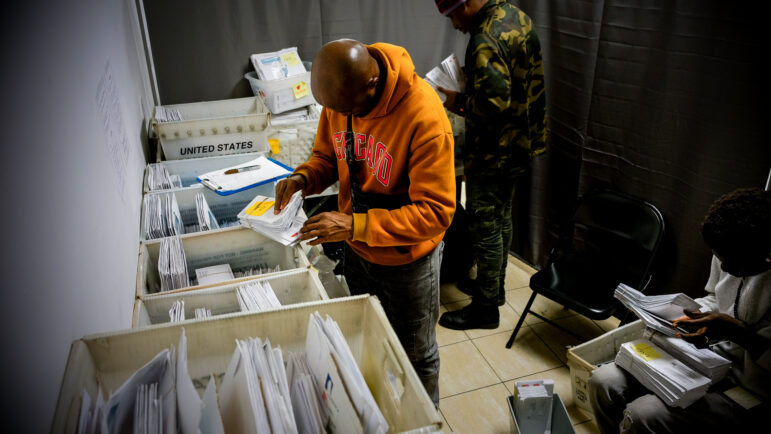The going rate for smuggling an illegal immigrant from China’s Pacific coast port towns of Fuzhou and Wenzhou into the United States has hit $47,000. Big Sister Ping, the “smuggling Queen of New York,” has made some $40 million off the business, observes author Peter Kwong. Her trade has “practically emptied out several villages around Fuzhou.”
She and thousands of other “snakeheads” have created an industry whose scope and profits rival the international drug trade. But unlike drug trafficking, the transport in human contraband is vital to American business interests. Forbidden Workers argues that supplying this cheap labor to a world economy increasingly focused on flexible, decentralized production serves business by eroding working conditions, depressing wages for all workers and destabilizing American unions. Kwong has written perhaps the single best book on working people in years.
Forbidden Workers focuses on a population that arrives in the U.S. horrendously in debt to traffickers and fearful of deportation, easy prey to victimizing employers and gangsters, and ignorant of the larger world outside. This is where Kwong’s descriptive and analytical powers are sharpest. New York’s Chinatown papers are simply the local editions of Hong Kong, Taiwan or mainland China sheets, so information about life in the rest of the city is a luxury. Federal legislation imposing sanctions on companies that hire illegals is virtually toothless. Because of the threat of deportation, appeals to civil authorities put workers, not owners, at risk. And the New York State Apparel Taskforce, set up to investigate employer abuses, is a paper tiger with just five inspectors on its payroll.
Kwong, who teaches urban planning at Hunter College and directs its Asian-American Studies program, doesn’t blame immigrants for wanting to come to the “Golden Mountain.” Instead, he focuses on the Taiwanese crime syndicates, the privatizing Chinese government, opportunistic U.S. employers and operators of what Kwong calls the “ethnic subcontracting system.” It is this system of hiring and exploiting illegal immigrants that makes labor “cheap” by giving today’s bosses the leverage they need to compel home work and child labor, withhold wages and routinely violate the minimum wage laws.
Given this, Kwong asserts that “the undocumented Fuzhounese immigrant workers are not that different from the rest of the American working people, they only happen to be on the breaking edge of the crumbling working-class structure.”
Many immigrants arrive with strong and distinct kinship, village, trade and fraternal ties. But for the Fuzhounese, there are few traditional organizations that cut across class lines, so organizing is difficult. When these workers are inspired to protest, when the Chinatown restaurant staff workers or the Sunset Park garment workers take on the owners, tong leaders and snakeheads, they provide useful organizing lessons for the whole labor movement.
Unfortunately, Kwong’s narrative gets tongue-tied when he begins to describe his most cutting edge ideas. A key argument, which I am sympathetic to, is that unions have been negligent, and even complicit, in allowing industries through the ethnic subcontracting system, to move “more and more high-wage jobs into the ‘secondary sector’ crowded with workers competing for lower wages.” In other words, many unions, in order to hold onto their existing contracts in highly competitive industries, like corporate cafeterias and light manufacturing, are lubricating the general wage slide by negotiating deals that match the inferior wage and working conditions offered by non-union subcontractors.
That’s a gutsy point of view, given New York City’s left political culture, where any union leader with the thinnest progressive credentials gets a free ride. Just look at how many wet kisses were plastered on the new Working Families Party, including some in the pages of this magazine, despite a vaporous agenda featuring the legislative goal of raising the state minimum wage. As Kwong documents, such standards are widely unenforced. Ginning up a legal minimum won’t prevent unionized employers from re-creating the conditions illegals now face in non-union shops.
Because the argument is controversial, it needs to be tacked down with the same elaboration and care Kwong gives to his portrait of the Fuzhounese. But his critique rests on throw-away lines about “organized labor’s racial hierarchy” that confuse form with content.
Kwong also rants about a union leadership that “no longer knows how to mobilize, being too old and ethnically different from the rank and file, yet it is unwilling to give away institutionalized power to a new ethnic group.” To paraphrase Lenny Bruce, the union tops don’t have to know how to organize, as long as they’ve got some men and women on staff who do. Given how Kwong excoriates traditional Fuzhounese leaders, it is bizarre that he would place any hope in ethnic succession as a road to more responsive union leadership.
Just how union leaders went from organizing dervishes to today’s back-slapping suits that fear challenge from everybody, not just new ethnic groups, Kwong doesn’t explain. Still, it takes courage and smarts to promote the idea that “an elitist from-the-top-down organizing approach” cannot work and that militant, democratic unions are a precondition for any political turnaround.
Michael Hirsch is a City Limits contributing editor who regularly writes on labor and political issues.








